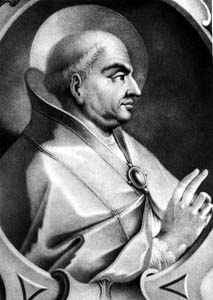Pope Martin I
|
Pope Saint Martin I |
|
|---|---|
 |
|
| Papacy began | 21 July 649 |
| Papacy ended | 16 September 655 |
| Predecessor | Theodore I |
| Successor | Eugene I |
| Personal details | |
| Born | 21 June 598 Near Todi, Umbria, Byzantine Empire |
| Died | 16 September 655 Cherson, Byzantine Empire |
|
Papal styles of Pope Martin I |
|
|---|---|
 |
|
| Reference style | His Holiness |
| Spoken style | Your Holiness |
| Religious style | Holy Father |
| Posthumous style | Saint |
Pope Martin I (Latin: Martinus I; born between 590 and 600, died 16 September 655) reigned from 21 July 649 to his death in 655. He succeeded Pope Theodore I on 5 July 649. He was the only pope during the Byzantine Papacy whose election was not approved by a iussio from Constantinople. Martin I was abducted by Emperor Constans II and died at Cherson. He is considered a saint and martyr by the Catholic Church and the Eastern Orthodox Church.
He was born near Todi, Umbria, in the place now named after him (Pian di San Martino). According to his biographer Theodore, Martin was of noble birth, of commanding intelligence, and of great charity to the poor. Piazza states that he belonged to the order of St. Basil. He had acted as papal apocrisiarius or legate at Constantinople, and was held in high repute for his learning and virtue.
Martin I was the last Constantinopolitan apocrisiarius to be elected pope. Other envoys under the title nuncio have been elected since then, like Pius XII.
At that time Constantinople was the capital of the Byzantine empire and the patriarch of Constantinople was the most influential Church leader in the eastern Christian world. After his election, Martin had himself consecrated without waiting for the imperial confirmation. One of his first official acts was to summon the Lateran Council of 649 to deal with the Monothelites, whom the Church considered heretical. The Council met in the church of St. John Lateran. It was attended by 105 bishops (chiefly from Italy, Sicily, and Sardinia, with a few from Africa and other quarters), held five sessions or secretarii from 5 October to 31 October 649, and in twenty canons condemned Monothelitism, its authors, and the writings by which Monothelitism had been promulgated. In this condemnation were included not only the Ecthesis (the exposition of faith of the Patriarch Sergius for which the emperor Heraclius had stood sponsor), but also the typus of Paul, the successor of Sergius, which had the support of the reigning Emperor (Constans II).
...
Wikipedia
